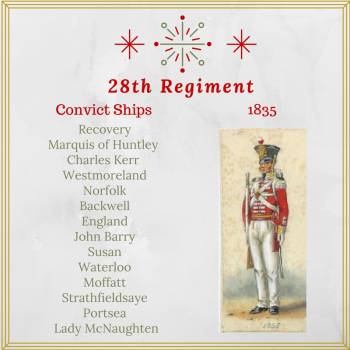Convict Ship Waterloo (5)
1836
Voyage: 108 days
Deaths: 2
Surgeon's Journal: yes
Previous vessel: Moffatt arrived 31st August 1836
Next vessel: Elizabeth arrived 12 October 1836
Captain John Cow
Surgeon George Roberts R.N.
Follow the Irish Convict Ship Trail
Convicts and passengers of the Waterloo identified in the Hunter Valley region
Prisoners were transported to New South Wales in 1829, 1831, 1833, 1836 and 1838 and to Van Diemen's Land in 1835. Two hundred and twenty-four convicts from counties throughout Ireland were embarked on the Waterloo at Dublin and Cork in May 1836.[1]
The Convicts
They had been sentenced to transportation for offences including assault, stealing, vagrancy, highway robbery, house breaking, picking pockets, manslaughter, embezzlement and also for white boy and firearm offences......... John Butler, James Carty, Cornelius Clohessy, Michael Clohessy, Owen Coleman, John Commons, Simon Connors, John Creimegan, Thomas Cullen, Lawrence Cunningham, John Kilroy, Thomas Lynch, John Mulhearn, Denis Read, James Reardon and Lawrence Rowan were all convicted of various white boy crimes.The youngest prisoners on board were John Rochford, John Quinlan, John Morony, James McCabry and Patrick Foley all fourteen years of age. [2]
Surgeon George Roberts
George Roberts kept a Medical Journal from 15 April to 10 September 1836.....The prisoners when they came on board, were apparently healthy although they seemed in a low state from deficient nourishment. The Waterloo weighed anchor almost immediately the convicts were embarked and although the weather was fine they still suffered much from sea sickness which caused great debility. They were also unaccustomed to cocoa and were unable to use it. There was little illness amongst the prisoners during the voyage, just a few trifling complaints, never more than 5 or 6 at a time. [1]
Free Passengers
Passengers included Major Cotton, Mrs. Cotton and 4 children.Military Guard
Lieut. Mackay of 28th regt., 20 rank and file of the 28th and 9 of the 50th regiment; 7 women and 5 children.Departure
The Waterloo departed Dublin on the 21st May 1836.The Voyage
At 8 o'clock every morning the prisoners were ordered upon deck and remained until twelve when the prison was thoroughly cleaned and freely ventilated. The prison decks were either dry scraped or dry stoned. Lime juice and sugar were issued in the proportion of an ounce of each to a man mixed in a pint of water and one half given fore and afternoon . This was continued during the period that the ship was passing through the tropics and on getting to the southward and eastward when the temperature became much colder an allowance of wine was added. The voyage was without a symptom of scurvy and the prisoners were landed in excellent health.The four men treated by George Robert's who were mentioned in his journal were:
William Johnston - A stout athletic man with a pale anxious countenance
John Honan - Of a weak habit of body, occasioned from irregular habits.
John Lawler - Of a scrofulas habit of body.
John Hassen - Naturally of a weak habit of body and shattered constitution from previous bad habits. [1]
Port Jackson
The Waterloo arrived in Port Jackson on 6th September 1836.The were mustered on board. The printed convict indents included information such as name, age, education, marital status, native place, offence, trade, when and where convicted, former convictions and physical descriptions.
They were landed on Saturday 10th September and marched to the Hyde Park Barracks for the purpose of assignment.
Notes and Links
1). Convict Patrick Quilkan was assigned to the Australian Agricultural Company on arrival. In 1839 was executed for murder.2). The Commission - Dublin - Saturday.... Pat. Quinlan (Quilkan?), convicted of feloniously killing a cow was sentenced to transportation for life....
John Byrne, sheep stealing; transportation for life;
Anthony Casey, manslaughter; seven years transportation;
John Orr, housebreaking; 14 years transportation;
James Reddy, uttering a forged note knowing it to be forged; transportation for life. - Freeman's Journal 2 November 1835
3). Convicts and passengers of the Waterloo identified in the Hunter Valley region
4). George Roberts was also employed as surgeon on the convict ships Lord Melville in 1830 and the Heroine in 1833

5). Political Prisoners
6). Return of convicts who died in 1870.
7). The convict ship Waterloo under Captain Henry Agar and surgeon Henry Kelsall was wrecked at Table Bay in 1842 while on the voyage from Sheerness to Tasmania.
8. Convict ships bringing detachments of the 28th regiment included the Recovery, Lady McNaughten, Charles Kerr, Westmoreland, Marquis of Huntley, Norfolk, Backwell, England, John Barry, Susan Waterloo, Moffatt, Strathfieldsaye and Portsea.
↑
